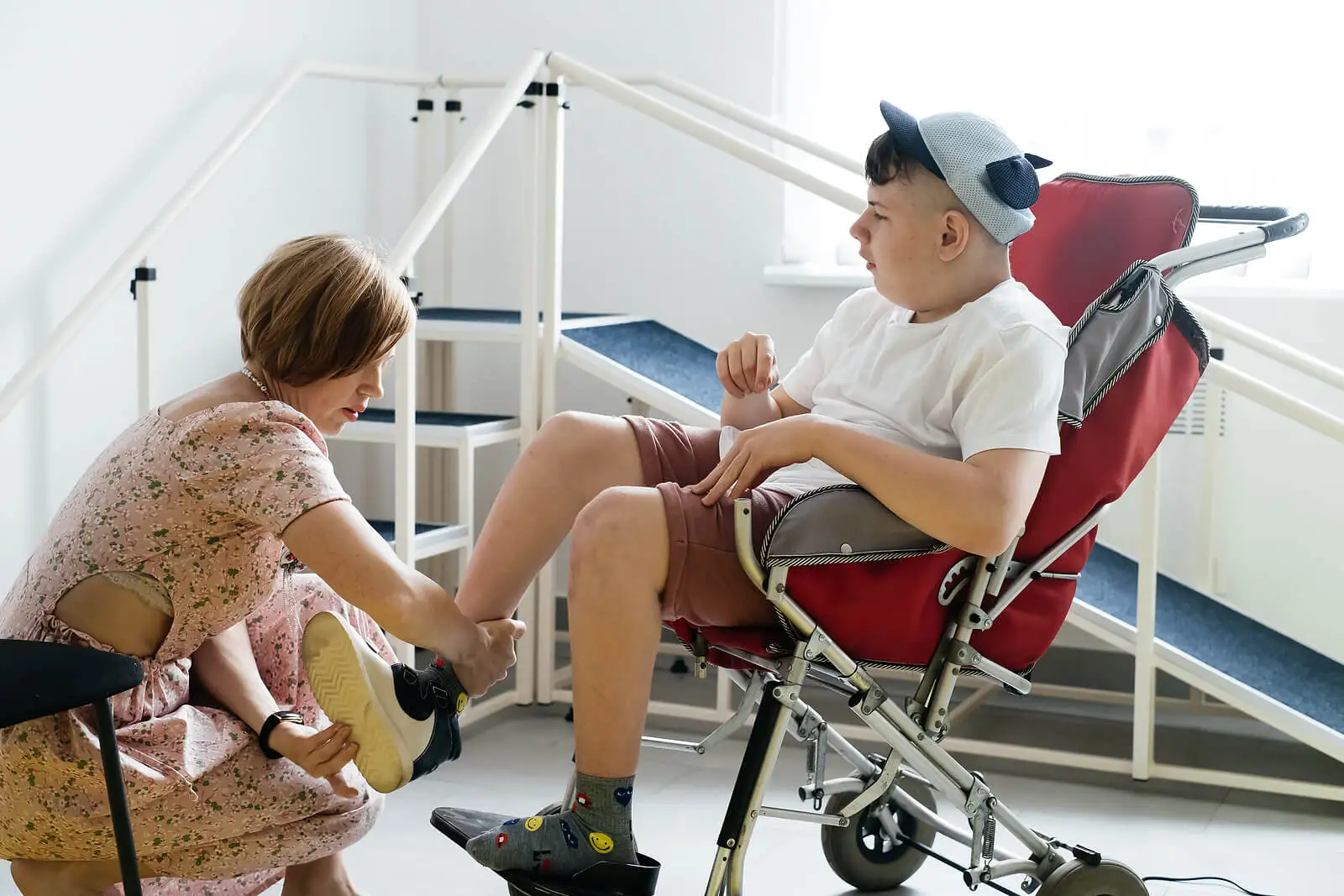Physical Therapy for Cerebral Palsy: What Does it Do?


Written and verified by the doctor Mariel Mendoza
Physical therapy for cerebral palsy is a fundamental pillar in the treatment since it improves the quality of life of people who suffer from it. In both adults and children, it can stimulate movement patterns, reduce muscle contractures and, above all, provide independence and autonomy.
Research shared through the Indian Journal of Orthopaedics highlights that these therapeutic measures are key to stimulating motor skills, improving cardiorespiratory fitness, and reducing the risk of complications. In this article, we’ll take a closer look at how it’s implemented and the important functions it performs.
What is cerebral palsy?
Cerebral palsy-more than an entity-is a group of developmental disorders of movement and posture that cause activity limitation. It’s attributed to non-progressive aggression on the developing brain during the fetal period or in the first five years of life (when the brain is still immature).
Although it’s characterized by alterations of the motor system (fine and gross), it’s usually also accompanied by the following:
- Sensory disorders
- Cognitive problems
- Communication difficulties
- Perceptual disorders
- Behavioral problems
- Pain
- Urinary incontinence
- Secondary musculoskeletal problems
- Epilepsy
Therefore, early detection of disabilities and early introduction of physical therapy are an essential part of the development of those who suffer from it.

Classification of cerebral palsy
First of all, to understand the impact of physical therapy on cerebral palsy, it’s necessary to classify it. In this way, it’s possible to determine the appropriate approach and its evolutionary prognosis. Conventionally, the classification is as follows:
- According to the degree of motor damage
- According to the typographic distribution
- According to the functional severity
Spastic, dyskinetic, ataxic, hypotonic, or mixed
According to motor damage, this condition may be classified as follows:
- Spastic cerebral palsy: This is the most common form. It forms a heterogeneous group according to the topographic distribution of increased muscle tone. Spasticity is characterized by tense and rigid muscles with the inability to relax. It includes tetraplegia (involvement of all four limbs), paraplegia (a most frequent form with predominant involvement of the lower limbs), and hemiplegia (there’s the involvement of half of the body with greater involvement of the upper limb).
- Diskinetic cerebral palsy: This manifests with abrupt changes in muscle tone with the presence of involuntary movements and the persistence of primitive reflexes. According to its clinical presentation, it’s differentiated into choreoathetotic (chorea, athetosis, tremor), dystonic, and mixed.
- Ataxic cerebral palsy: There’s a decrease in muscle tone with motor incoordination, dysmetria, imbalance, and ataxia.
- Hypotonic cerebral palsy: This is very rare. In this case, there is decreased muscle tone with an increased response to osteotendinous reflexes.
- Mixed cerebral palsy: This occurs when the motor disorder is not pure and combines some of the above. The most frequent are the combination of dystonia and spasticity, or ataxia and dystonia.
The topography depends on the affected limbs and severity in limiting daily activities
According to their topographical distribution, they can be classified as follows:
- Tetraplegia
- Diplegia
- Hemiplegia
- Paraplegia
- Monoplegia
Finally, depending on its functional severity, cerebral palsy may be classified as mild, moderate, or severe. In the case of mild severity, it doesn’t limit daily activities; moderate severity requires assistance or support to perform daily activities; meanwhile, severe severity requires support for all activities.
Physical therapy for cerebral palsy
In the management of cerebral palsy, a multidisciplinary team is necessary for adequate assessment and comprehensive care. Treatment should be individualized, specialized, and sustained in accordance with the person’s family, social, and school environment.
From the point of view of the motor disorder, the basis of treatment is physical therapy. The technique will depend on the patient’s condition and age.
Neurodevelopmental treatment
Also known as “NDT” or the “Bobath method,” this is based on inhibiting abnormal muscle reflexes with the reduction of muscle tone. Various techniques are used with the aim of facilitating normal posture, various movement patterns, and correct reflexes.
Its premise is that the presence of normal postural reflex mechanisms is fundamental to the performance of a certain motor skill. This refers to straightening and balance reactions, reciprocal innervation, and coordination patterns.
It seeks to reduce muscle tone to improve movement through the use of mobilization of stiff muscles and joints, muscle stretching, and the practice of more normal movement patterns. It also aims for a more efficient and less strenuous performance of functional tasks and weight bearing.
Constraint-induction movement therapy
Known by its acronym CIMT, this therapy is used in cases of mid-body involvement to improve the function of the affected limb. In this case, the stronger limb is immobilized for a variable time to force the use of the disabled limb over time.
Pattern following
Also known as patterning, this is based on the principle that progress and development are guided by a sequence that is well-established and predetermined. Thus, when it fails, difficulty in the development of the next steps occurs.
Under this premise, motor activity in people with cerebral palsy can be facilitated by passive and prolonged repetition of typical sequential developmental steps.
We think you may also enjoy reading this article: 6 Ways to Take Care of Your Body for Physical and Mental Balance
Body-weight-bearing treadmill training
This technique is based on the primitive reflex of the newborn and infant before weight-bearing, standing, or attempting to walk on a flat surface. In this case, the person with cerebral palsy is placed on a treadmill to simulate walking with body weight support.
This allows for improved balance and increased muscle strength in the lower limbs, which facilitates walking without support. It especially helps those with spastic cerebral palsy, as it enhances a person’s walking ability and decreases asymmetry in standing due to weight distribution.
Stretching exercises
In the case of cerebral palsy, there’s often an increase in muscle tone or resistance to stretching. Therefore, this method is based on manual stretching to relieve muscle tension. This achieves the following:
- Improve the range of motion
- Reduce spasticity
- Improve walking efficiency
Generally, rapid or short, prolonged, or sustained stretching techniques are employed. This can also be done by using the effect of body weight and gravity or mechanically with machines or splints. This helps to passively lengthen the muscle by overcoming resistance.
Another way to implement this type of physical therapy is with static weight bearing. For this, tilt tables, splints with splints or casts, or standing frames are used. This improves antigravity muscle strength, reduces spasticity, stimulates motor function, and reduces swelling.

Like this article? You may also like to read: The Best and Most Effective Physiotherapy Treatments
Muscle strengthening exercises
As specific functional exercises according to the particular disabilities, exercise bikes, treadmills, plyometric exercises, or bimanual stimulation can be used.
Hydrotherapy
The use of therapeutic bathtubs brings several advantages to cerebral palsy treatment. In addition to helping psychic and cardiovascular adaptation, it restores control of body balance. Hydrotherapy also promotes blood circulation and temperature regulation, which decreases the heart rate.
The warm climate of hydrotherapy reduces muscle tone and thus improves spasticity and allows greater freedom of mobilization. In this way, muscular endurance and strength are benefited. On the other hand, it also has relaxing benefits and improves coordination, which translates into improved physical agility.
Cerebral palsy treatment is based on improving a person’s quality of life
The main objective of cerebral palsy treatment is to help achieve the maximum functional level of independence. Treatments should be individualized and adapted to a person’s environment.
Physical therapy for cerebral palsy implements strength and flexibility exercises for posture and overall mobility. It also improves pain and prevents muscle spasms and contractures.
Therefore, it improves balance, coordination, strength, flexibility, pain management, posture, endurance, and overall quality of life. However, it’s important to implement treatments in a timely manner to improve future prognosis.
The treatment is more effective the earlier it’s done, since there’s a lot of neuronal plasticity during the first years of life, which allows for the development or increase of new synaptic connections.
All cited sources were thoroughly reviewed by our team to ensure their quality, reliability, currency, and validity. The bibliography of this article was considered reliable and of academic or scientific accuracy.
- Anttila H, et al. Effectiveness of physical therapy interventions for children with cerebral palsy: A systematic review. BMC Pediatr. 2008; 8. Disponible en https://www.ncbi.nlm.nih.gov/pmc/articles/PMC2390545/.
- Gbonjubola Y, et al. Physioterapy management of children with cerebral palsy. Adesh Universty Journal of Medical Sciences & Research 2021;3(2). Disponible en https://aujmsr.com/view-pdf/?article=f96b0d394c9640d9e88a0b3f731fe91f859rjbzReVw=.
- Gómez S, Jaimes VH, Palencia M, Hernández M, Guerrero A. Parálisis cerebral infantil. Arch Venez Puer Ped. 2013; 76(1):30-39.
- González M. Fisioterapia en neurología: estrategias de intervención en parálisis cerebral. Umbral Científico [Internet] 2005;(7):24-32. Disponible en https://www.redalyc.org/articulo.oa?id=30400704.
- Latorre J, et al. Influencia de la fisioterapia acuática sobre las habilidades motoras gruesas de los niños afectados de parálisis cerebral: Revisión sistemática. JONNPR 2017;2(5):210-216. Disponible en https://dialnet.unirioja.es/servlet/articulo?codigo=5972914.
- Das SP, Ganesh GS. Evidence-based Approach to Physical Therapy in Cerebral Palsy. Indian J Orthop. 2019 Jan-Feb;53(1):20-34. doi: 10.4103/ortho.IJOrtho_241_17. PMID: 30905979; PMCID: PMC6394183.
- Prasad S, Shankar G. Evidence-based Approach to Physical Therapy in Cerebral Palsy. Indian J Ortop 2019;53(1). Disponible en https://www.ncbi.nlm.nih.gov/pmc/articles/PMC6394183/#:~:text=Physiotherapy%20plays%20a%20key%20role%20in%20the%20management%20of%20CP,as%20CP%20receive%20physiotherapy%20services.&text=The%20goals%20of%20physiotherapy%20are,physical%20impairments%20of%20the%20symptoms.
- Weitzman M. Terapias de rehabilitación en niños con o en riesgo de parálisis cerebral. Rev Ped Elec, 2005;2(1).
This text is provided for informational purposes only and does not replace consultation with a professional. If in doubt, consult your specialist.








